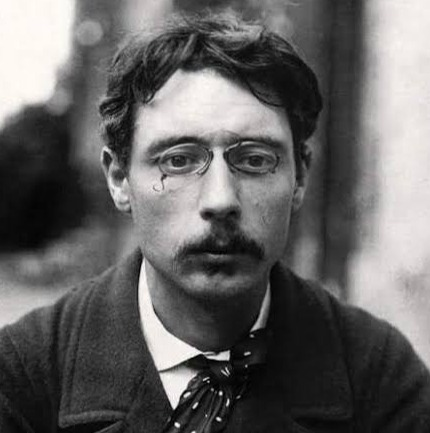
Pierre Bonnard
French artist Pierre Bonnard belonged to the Symbolist painters' group called Les Nabis ("prophets" or "seers"). Despite being part of this group, Bonnard did not engage with obscure Symbolist themes nor was he a mystic. Instead, he found contentment joy, and fascination in depicting the everyday scenes of simple life around him. This has led to Bonnard being referred to as an "intimist."
Biography of Pierre Bonnard
Pierre Bonnard was born in Fontenay-aux-Roses, Hauts-de-Seine, in 1867. His father directed Bonnard toward studying law at the Sorbonne from 1885 to 1888. He earned a Baccalaureate, excelling in the Classics, and briefly practiced law in a government office as his father wished. Concurrently, Bonnard also attended art classes at the École des Beaux-Arts, where he did not succeed in winning the Prix de Rome (an opportunity to study at the French Academy in Rome).
Thus, the artist switched to the Académie Julian in 1889, where he crossed paths with Maurice Denis, Paul Sérusier, Ker-Xavier Roussel, Paul Ranson, Félix Vallotton, and Édouard Vuillard. This encounter led him to embrace an artistic path, and by 1890, he shared a Montmartre studio with Denis and Vuillard. Their group later expanded to include theatrical producer Aurélian Lugné-Poe, with whom Bonnard collaborated on productions for the Théâtre de l'Oeuvre in Paris.
In 1891, Bonnard crossed paths with Henri de Toulouse-Lautrec and began exhibiting his art at the annual Société des Artistes Indépendants exhibition. That same year marked the beginning of his collaboration with La Revue Blanche, where he and his friend Vuillard designed frontispieces. His lithographs were published in 1895 by the renowned art dealer Ambroise Vollard, and during this time, he also created a stained glass window for Louis Comfort Tiffany. Bonnard held his inaugural solo exhibition at Galerie Durand-Ruel in 1896.
The artist's wife Marthe de Méligny, whom he had encountered in 1893, remained a consistent subject for several decades. They did not marry until 32 years later in 1925, when Bonnard learned her true name was Maria Boursin. Allegedly, she had fled her home, falsifying her age and background for many years. Despite this, she became the (at times) obsessively depicted muse in his art, appearing in as many as 385 paintings. Bonnard also took intimate photographs of her, later incorporating these into his artworks.
Alongside these portraits, Bonnard painted numerous self-portraits, landscapes, street scenes, and still lifes featuring flowers and fruit. He had a practice of working on multiple canvases simultaneously, which he pinned to the walls of his modest studio.
In 1926, Bonnard relocated to Le Cannet near Cannes in southern France. A significant exhibition of his and Vuillard's work took place at the Art Institute of Chicago in 1938. Throughout World War II, he remained in Le Cannet, living in seclusion even after his wife passed away in 1942.
Before his death, Pierre Bonnard completed the sizable mural "Saint Francis Healing the Sick" (1947) for the Church of Assy. His final painting, "The Almond Tree in Blossom" (1947), was finished just a week before he passed away in his cottage on La Route de Serra Capeou near Le Cannet on the French Riviera. Following his death, the Museum of Modern Art in New York organized a retrospective of Bonnard's work in 1948, originally intended as a celebration of his 80th birthday. Despite his avoidance of public attention, Bonnard's art had sold well during his lifetime.
Pierre Bonnard's Art Style
In his twenties, Pierre Bonnard became a member of Les Nabis, a collective of young artists devoted to creating art with symbolic and spiritual depth. His peers affectionately dubbed him a "highly Nipponized Nabi," referencing the influence of Japanese prints on his work. This Japanese influence, known as Japonism, had also impacted the styles of the Impressionists and Post-Impressionists.
In 1900, illustrating poet Paul Verlaine's Symbolist poetry collection Parallèlement, Bonnard ventured into painting landscapes reminiscent of Impressionist and Paul Gauguin's styles in the areas between Paris and Normandy.
By 1907, Bonnard embarked on extensive travels throughout Europe and North Africa, yet these journeys seemed to have minimal impact on his artistic style. Departing Paris in 1910 for the south of France, his art showed little trace of the war's influence, save for a few sketches with war themes. Described by historians and friends alike as a man of a "quiet temperament," he led an unobtrusively independent life. His artworks, often intricate in composition, typically depicted sunlit interiors of rooms and gardens populated by friends and family, revealing a blend of narrative and autobiography.
As the artist aged, he returned to the vibrant light and color of his earlier artistic style. At the time of his passing, Bonnard's legacy had been somewhat overshadowed by the avant-garde movements emerging in the art world.
Pierre Bonnard is often categorized as a late Impressionist, yet this classification fails to capture his significant contributions to painting. Instead, his work is characterized by a distinct use of color that both enriched and transcended the Impressionist palette. His application of overlapping planes of color even seems to foreshadow the Cubists' exploration of intersecting planes.
Years:
Born in 1867
Country:
France, Fontenay-aux-Roses
Gallery: